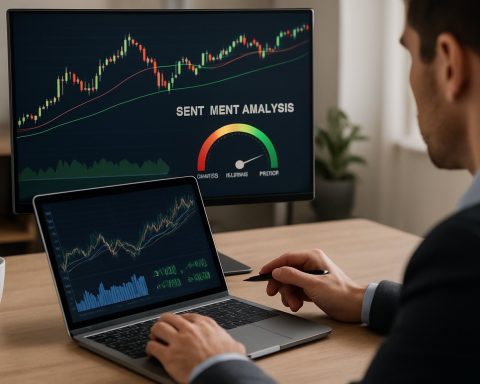Exoskeleton Robotics in Industrial Warehousing: The Game-Changer Transforming Worker Safety, Productivity, and the Future of Logistics. Discover How Cutting-Edge Wearable Robots Are Reshaping the Warehouse Floor.
- Introduction: The Rise of Exoskeleton Robotics in Warehousing
- How Exoskeletons Work: Technology and Design Innovations
- Boosting Worker Safety and Reducing Injuries
- Productivity Gains: Real-World Case Studies and Metrics
- Integration Challenges and Solutions in Existing Warehouses
- Cost-Benefit Analysis: ROI and Long-Term Value
- Impact on Workforce Dynamics and Job Roles
- Future Trends: AI, Automation, and the Next Generation of Exoskeletons
- Conclusion: The Road Ahead for Exoskeleton Robotics in Industrial Warehousing
- Sources & References
Introduction: The Rise of Exoskeleton Robotics in Warehousing
The rapid evolution of industrial warehousing has been significantly influenced by the integration of exoskeleton robotics, marking a transformative shift in how manual labor is approached. Exoskeletons are wearable robotic systems designed to augment human strength, endurance, and safety, enabling workers to perform physically demanding tasks with reduced risk of injury and fatigue. In the context of warehousing, these devices are increasingly being adopted to address challenges such as labor shortages, high injury rates, and the need for greater operational efficiency.
The rise of exoskeleton robotics in warehousing is driven by several converging factors. The global surge in e-commerce has intensified the demand for faster and more reliable order fulfillment, placing additional strain on warehouse personnel. At the same time, the aging workforce and persistent musculoskeletal injuries have prompted companies to seek innovative solutions that protect workers while maintaining productivity. Exoskeletons offer a promising answer by providing physical support during repetitive lifting, carrying, and overhead tasks, thereby reducing the incidence of workplace injuries and absenteeism.
Recent advancements in lightweight materials, sensor technologies, and ergonomic design have made exoskeletons more practical and accessible for industrial applications. Major logistics and manufacturing companies are piloting and deploying these systems to enhance worker well-being and operational throughput. According to Occupational Safety and Health Administration, musculoskeletal disorders account for a significant portion of workplace injuries in warehousing, underscoring the potential impact of exoskeleton adoption. As the technology matures, exoskeleton robotics are poised to become a cornerstone of modern industrial warehousing, reshaping the future of manual labor and workplace safety.
How Exoskeletons Work: Technology and Design Innovations
Exoskeleton robotics in industrial warehousing leverage advanced technology and innovative design to augment human capabilities, particularly in tasks involving heavy lifting, repetitive motion, and awkward postures. These wearable devices typically consist of a mechanical frame, actuators or motors, sensors, and a control system that synchronizes the exoskeleton’s movements with the user’s natural motions. Modern industrial exoskeletons are often constructed from lightweight yet durable materials such as carbon fiber or aluminum alloys, ensuring both strength and user comfort during extended use.
A key technological innovation is the integration of real-time sensor feedback, which allows the exoskeleton to detect the user’s intent and provide proportional assistance. For example, force and motion sensors embedded in the joints monitor the wearer’s movements, enabling the exoskeleton to amplify lifting power or reduce strain on specific muscle groups. Some systems employ artificial intelligence algorithms to adapt assistance levels dynamically, optimizing support based on the task and the user’s fatigue levels. Additionally, ergonomic design considerations, such as adjustable fittings and modular components, ensure that exoskeletons can accommodate a wide range of body types and warehouse tasks.
Recent advances also include the development of passive exoskeletons, which use mechanical springs and dampers to redistribute loads without the need for external power sources, and active exoskeletons, which rely on electric or pneumatic actuators for greater force amplification. These innovations are being tested and deployed in real-world settings by organizations such as Ford Motor Company and SuitX, demonstrating significant reductions in worker fatigue and injury rates. As technology evolves, exoskeletons are expected to become more intuitive, affordable, and seamlessly integrated into industrial warehousing operations.
Boosting Worker Safety and Reducing Injuries
Exoskeleton robotics are increasingly being adopted in industrial warehousing to address persistent challenges related to worker safety and injury reduction. Manual material handling tasks, such as lifting, carrying, and repetitive movements, are leading contributors to musculoskeletal disorders (MSDs) among warehouse employees. These injuries not only impact worker well-being but also result in significant costs due to lost productivity and compensation claims. Exoskeletons, designed to augment human strength and endurance, provide mechanical support to the back, shoulders, and lower limbs, thereby reducing the physical strain associated with demanding warehouse tasks.
Recent field studies have demonstrated that the use of exoskeletons can significantly decrease muscle fatigue and lower the risk of acute and chronic injuries. For example, passive exoskeletons redistribute loads away from vulnerable joints, while powered models actively assist with lifting and sustained postures. This technology enables workers to perform physically intensive tasks with less effort and a reduced likelihood of overexertion injuries. Furthermore, exoskeletons can help extend the working life of older employees and those with pre-existing conditions, promoting a more inclusive workforce.
Major logistics and retail companies are piloting exoskeletons in their warehouses, reporting early success in reducing injury rates and improving overall ergonomics. Regulatory bodies and occupational health organizations are also recognizing the potential of exoskeletons as part of comprehensive workplace safety strategies (Occupational Safety and Health Administration; National Institute for Occupational Safety and Health). As the technology matures, exoskeletons are poised to become a standard tool for safeguarding warehouse workers and minimizing the human and financial costs of workplace injuries.
Productivity Gains: Real-World Case Studies and Metrics
The integration of exoskeleton robotics in industrial warehousing has demonstrated measurable productivity gains, as evidenced by several real-world case studies and performance metrics. For instance, a pilot program conducted by Ford Motor Company equipped warehouse workers with upper-body exoskeletons, resulting in a reported 15% reduction in task completion time for repetitive overhead work. Similarly, DHL Supply Chain implemented exoskeletons in select European distribution centers, observing a 20% increase in picking efficiency and a notable decrease in worker fatigue and absenteeism.
Quantitative metrics from these deployments often include improvements in pick rates, reductions in musculoskeletal injuries, and enhanced worker satisfaction. For example, a study by Occupational Safety and Health Administration (OSHA) found that exoskeleton-assisted workers experienced up to 30% fewer strain-related incidents, directly correlating with fewer lost workdays and lower compensation claims. Additionally, Honeywell reported that after introducing exoskeletons in their logistics operations, average order fulfillment times dropped by 12%, while error rates remained stable or improved.
These case studies underscore the potential of exoskeleton robotics to not only boost productivity but also enhance workplace safety and employee well-being. The consistent positive outcomes across diverse warehousing environments suggest that, when properly implemented, exoskeletons can deliver significant operational advantages and measurable returns on investment.
Integration Challenges and Solutions in Existing Warehouses
Integrating exoskeleton robotics into existing industrial warehouses presents a unique set of challenges, primarily due to the complexity and variability of legacy infrastructure. One major hurdle is the physical layout of warehouses, which are often not designed with robotic augmentation in mind. Narrow aisles, uneven flooring, and limited maneuvering space can impede the effective use of exoskeletons, necessitating modifications or adaptive technologies to ensure worker safety and operational efficiency. Additionally, compatibility with current warehouse management systems (WMS) and workflows is critical; exoskeletons must seamlessly interface with digital tracking, inventory, and task allocation platforms to avoid disruptions and maximize productivity.
Another significant challenge is workforce adaptation. Employees may require extensive training to operate exoskeletons safely and efficiently, and there can be resistance to adopting new technologies due to concerns about job security or discomfort with wearable robotics. Addressing these issues involves comprehensive change management strategies, including participatory design processes and ongoing support.
Solutions to these integration challenges are emerging. Modular exoskeleton designs allow for customization to fit diverse warehouse environments, while advances in sensor technology enable real-time adaptation to dynamic conditions. Collaborative pilot programs, such as those supported by Occupational Safety and Health Administration (OSHA) guidelines, help identify best practices for safe deployment. Furthermore, partnerships between robotics manufacturers and logistics companies, exemplified by initiatives from Bosch Rexroth, are driving the development of interoperable solutions that can be retrofitted into existing operations with minimal disruption.
Cost-Benefit Analysis: ROI and Long-Term Value
A comprehensive cost-benefit analysis is essential for evaluating the return on investment (ROI) and long-term value of exoskeleton robotics in industrial warehousing. While the initial capital expenditure for acquiring and integrating exoskeleton systems can be significant, these costs must be weighed against the potential for substantial operational savings and productivity gains. Exoskeletons can reduce the incidence of musculoskeletal injuries among warehouse workers, leading to lower workers’ compensation claims, reduced absenteeism, and decreased turnover rates. For example, studies have shown that ergonomic interventions, such as exoskeletons, can cut injury rates by up to 60%, translating into considerable cost savings for employers Occupational Safety and Health Administration (OSHA).
In addition to direct savings, exoskeletons can enhance worker efficiency by enabling employees to handle heavier loads and perform repetitive tasks with less fatigue, potentially increasing throughput and reducing overtime expenses. Over time, these productivity improvements can offset the upfront investment, especially in high-volume warehousing environments. Furthermore, the adoption of exoskeletons can contribute to a positive workplace culture, supporting employee well-being and retention, which are critical factors in industries facing labor shortages U.S. Bureau of Labor Statistics.
However, organizations must also consider ongoing maintenance, training, and potential technology upgrades when calculating total cost of ownership. A well-structured ROI analysis should incorporate these factors, as well as the anticipated lifespan of the exoskeleton devices. Ultimately, while the financial outlay is non-trivial, the long-term value proposition of exoskeleton robotics in warehousing is increasingly compelling as technology matures and labor market pressures intensify National Institute for Occupational Safety and Health (NIOSH).
Impact on Workforce Dynamics and Job Roles
The integration of exoskeleton robotics in industrial warehousing is significantly reshaping workforce dynamics and job roles. By augmenting human strength and reducing physical strain, exoskeletons enable workers to handle heavier loads and perform repetitive tasks with less risk of musculoskeletal injuries. This technological advancement is particularly impactful in environments where manual material handling is prevalent, as it can extend the working life of employees and reduce absenteeism due to injury-related issues (Occupational Safety and Health Administration).
As exoskeletons become more common, the nature of warehouse jobs is evolving. Traditional roles that required significant physical exertion are being transformed into positions that emphasize the operation, monitoring, and maintenance of wearable robotic systems. This shift necessitates new skill sets, including basic technical literacy and the ability to troubleshoot or calibrate exoskeleton devices. Consequently, companies are investing in upskilling and reskilling programs to prepare their workforce for these changes (World Bank).
Moreover, the adoption of exoskeletons can foster a more inclusive workplace by enabling individuals who may not have previously met the physical demands of warehousing to participate in these roles. However, there are also concerns about job displacement and the potential for increased surveillance and productivity pressures, as wearable robotics can be equipped with sensors that monitor worker performance (International Labour Organization). Overall, exoskeleton robotics are driving a paradigm shift in industrial warehousing, balancing opportunities for enhanced worker well-being with the need for thoughtful workforce management.
Future Trends: AI, Automation, and the Next Generation of Exoskeletons
The future of exoskeleton robotics in industrial warehousing is being shaped by rapid advancements in artificial intelligence (AI), automation, and materials science. Next-generation exoskeletons are expected to integrate AI-driven adaptive controls, enabling real-time adjustments to user movements and warehouse environments. This will allow for more intuitive human-robot collaboration, reducing cognitive and physical strain on workers while enhancing productivity. For example, AI-powered exoskeletons can learn from user behavior, optimizing support for repetitive or strenuous tasks and even predicting potential injuries before they occur.
Automation is also driving the evolution of exoskeletons from passive assistive devices to active, semi-autonomous systems. These exoskeletons can communicate with warehouse management systems and other automated equipment, streamlining workflows and improving safety. The integration of Internet of Things (IoT) sensors will further enable data-driven insights into worker performance and equipment maintenance, supporting predictive analytics and continuous improvement initiatives.
Material innovations, such as lightweight composites and flexible actuators, are making exoskeletons more comfortable and less intrusive, encouraging wider adoption across diverse warehousing environments. As regulatory frameworks and ergonomic standards evolve, exoskeletons are likely to become a standard component of the industrial workforce, complementing other forms of automation such as autonomous mobile robots and robotic arms.
Industry leaders and research institutions are actively investing in these technologies, with pilot programs and collaborative projects underway globally (Occupational Safety and Health Administration; Fraunhofer Society). The convergence of AI, automation, and advanced exoskeleton design promises a safer, more efficient, and more sustainable future for industrial warehousing.
Conclusion: The Road Ahead for Exoskeleton Robotics in Industrial Warehousing
The integration of exoskeleton robotics in industrial warehousing marks a transformative step toward safer, more efficient, and sustainable operations. As the technology matures, exoskeletons are increasingly being recognized not only for their ability to reduce worker fatigue and injury but also for their potential to enhance productivity and job satisfaction. Early adopters have reported measurable improvements in ergonomics and reductions in musculoskeletal disorders, which are among the most common workplace injuries in warehousing environments (Occupational Safety and Health Administration).
Looking ahead, the road for exoskeleton robotics is paved with both opportunities and challenges. Continued advancements in lightweight materials, battery life, and sensor integration are expected to make exoskeletons more comfortable and adaptable to diverse tasks. Moreover, the integration of artificial intelligence and data analytics could enable real-time monitoring and personalized support, further optimizing worker performance (Fraunhofer Society). However, widespread adoption will require addressing concerns related to cost, user acceptance, and regulatory standards. Collaboration between manufacturers, researchers, and regulatory bodies will be crucial to developing guidelines that ensure safety and efficacy.
Ultimately, exoskeleton robotics have the potential to redefine the future of industrial warehousing, creating environments where human workers and robotic assistance coexist seamlessly. As research and pilot programs continue to demonstrate tangible benefits, it is likely that exoskeletons will become a standard feature in warehouses worldwide, driving the industry toward a new era of innovation and well-being (International Federation of Robotics).







